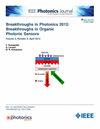Fabrication-Tolerant Single-Transverse-Mode Supersymmetric Laser Arrays
IF 2.4
4区 工程技术
Q3 ENGINEERING, ELECTRICAL & ELECTRONIC
引用次数: 0
Abstract
The semiconductor supersymmetric (SUSY) laser arrays have achieved single-transverse-mode operation with high output powers, which hold great potential for integrated optoelectronic devices for optical communication and ranging systems. However, the single-transverse-mode characteristics may deteriorate rapidly when the ridge waveguide width varies due to fabrication error. In this work, fabrication-tolerant single-transverse-mode SUSY laser arrays are designed using robust direct search (RDS) under the odd/even supermode double-sided coupling scheme. Two independent superpartners are introduced on both sides of the main array, with one coupling and eliminating the higher-order odd symmetry supermodes, and the other coupling and eliminating the higher-order even symmetry supermodes in the main array, enabling more efficient coupling of higher-order transverse modes into the lossy superpartners, which leads to the increased loss of high-order supermodes. RDS design method is used to improve the single-transverse-mode characteristics with fabrication tolerance, which considers the fabrication error in ridge waveguide width during the optimization process. The mode discrimination, defined as the difference between the modal gain of fundamental supermode and the highest modal gain among higher-order supermodes, is calculated to evaluate the transverse mode characteristics. Larger mode discrimination corresponds to better single-transverse-mode characteristics. We demonstrate odd/even supermode double-sided coupling SUSY laser arrays composed of five, seven and nine-ridge main array using the RDS, achieving average mode discrimination within ±0.1 μm ridge width variations of 36.61 GHz, 36.27 GHz, and 35.41 GHz, respectively, when the maximum mode discrimination is 50 GHz. Compared to conventional design method, the average mode discrimination increases by 8.21 GHz, 7.18 GHz, and 5.66 GHz, proving better single-transverse-mode characteristics with fabrication tolerance. The proposed fabrication-tolerant single-transverse-mode SUSY laser arrays could find potential applications in integrated optoelectronic devices for optical communication and ranging systems.制造公差单横模超对称激光阵列
半导体超对称(SUSY)激光阵列实现了高输出功率的单横模工作,在光通信和测距系统的集成光电器件中具有很大的潜力。然而,当脊波导宽度因制造误差而变化时,单横模特性会迅速恶化。本文采用鲁棒直接搜索(RDS)技术,在奇/偶超模双面耦合下设计了可容忍制造的单横模SUSY激光阵列。在主阵列两侧引入两个独立的超伴子,一个耦合并消除了主阵列中的高阶奇对称超模,另一个耦合并消除了主阵列中的高阶偶对称超模,使得高阶横向模更有效地耦合到损耗超伴子中,从而导致高阶超模的损耗增加。在优化过程中考虑了脊波导宽度的制造误差,采用RDS设计方法通过制造公差来改善单横模特性。计算模态辨识度,定义为基模态增益与高阶模态增益之间的差值,以评估横向模态特性。较大的模态判别对应较好的单横模特性。利用RDS实现了由5脊、7脊和9脊主阵列组成的奇偶超模双面耦合SUSY激光阵列,当最大模差为50 GHz时,平均模差分别为36.61 GHz、36.27 GHz和35.41 GHz,模差变化范围为±0.1 μm。与传统设计方法相比,该方法的平均模式识别率分别提高了8.21 GHz、7.18 GHz和5.66 GHz,具有更好的单横模特性和制造公差。所提出的可容忍制造的单横模SUSY激光阵列可以在光通信和测距系统的集成光电器件中找到潜在的应用。
本文章由计算机程序翻译,如有差异,请以英文原文为准。
求助全文
约1分钟内获得全文
求助全文
来源期刊

IEEE Photonics Journal
ENGINEERING, ELECTRICAL & ELECTRONIC-OPTICS
CiteScore
4.50
自引率
8.30%
发文量
489
审稿时长
1.4 months
期刊介绍:
Breakthroughs in the generation of light and in its control and utilization have given rise to the field of Photonics, a rapidly expanding area of science and technology with major technological and economic impact. Photonics integrates quantum electronics and optics to accelerate progress in the generation of novel photon sources and in their utilization in emerging applications at the micro and nano scales spanning from the far-infrared/THz to the x-ray region of the electromagnetic spectrum. IEEE Photonics Journal is an online-only journal dedicated to the rapid disclosure of top-quality peer-reviewed research at the forefront of all areas of photonics. Contributions addressing issues ranging from fundamental understanding to emerging technologies and applications are within the scope of the Journal. The Journal includes topics in: Photon sources from far infrared to X-rays, Photonics materials and engineered photonic structures, Integrated optics and optoelectronic, Ultrafast, attosecond, high field and short wavelength photonics, Biophotonics, including DNA photonics, Nanophotonics, Magnetophotonics, Fundamentals of light propagation and interaction; nonlinear effects, Optical data storage, Fiber optics and optical communications devices, systems, and technologies, Micro Opto Electro Mechanical Systems (MOEMS), Microwave photonics, Optical Sensors.
 求助内容:
求助内容: 应助结果提醒方式:
应助结果提醒方式:


